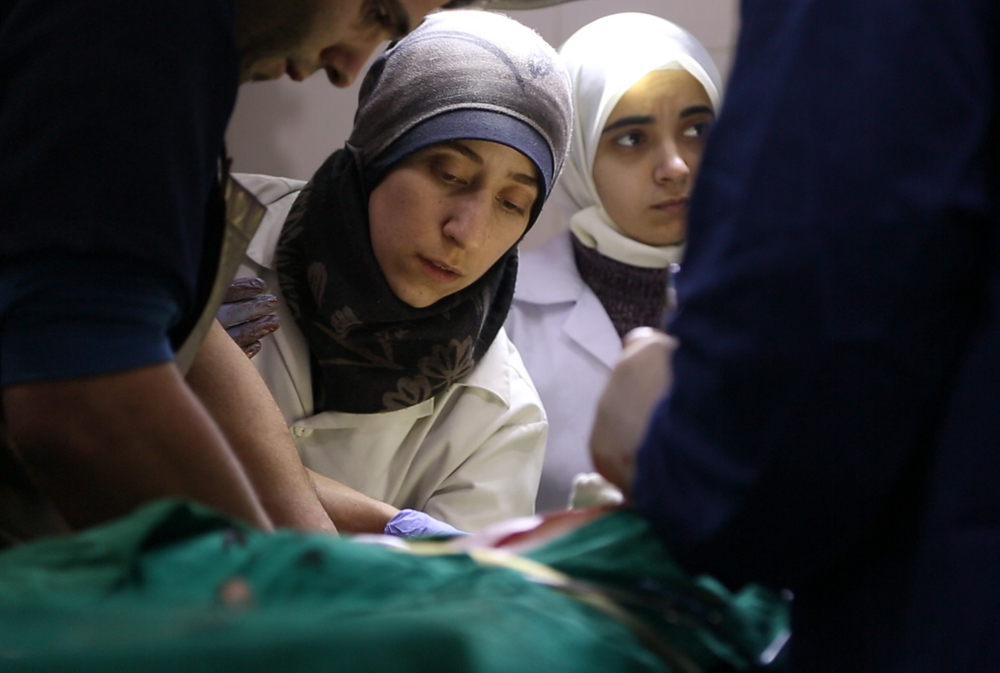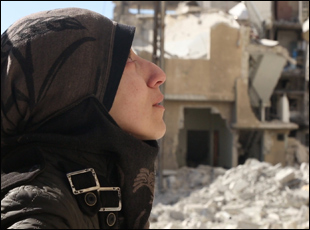There aren’t many light moments to be found in “The Cave,” but leave it to the brave and resilient medical staff still working at a hospital in Eastern Al Ghouta as the Syrian Civil War rages on above them to create their own fun, celebrating the birthday of Dr. Amani Ballour by blowing up rubber gloves to serve as festive balloons. Even when the kitchen rattles as the result of a bomb that strikes off in the distance, it is met with a hearty laugh from Samaher, one of the nurses who goes back to stirring chickpea flour for an all-too-rare meal of falafel as if someone had surprised her with an ultimately innocuous jump scare.
Director Feras Fayyad had seen many hospitals in his native Syria while making his previous film, the Oscar-nominated “Last Men in Aleppo,” since they had become the target of constant air attacks by Bashar al-Assad, the Syrian president who ironically had been trained to practice medicine at Damascus University. But he had never encountered a clinic like the one run by Dr. Amani, ingeniously using the subterranean levels of a six-story hospital that had been left uncompleted after the Syrian rebellion began to tend to the nearly 400,000 people that had migrated underground for survival as the military had seized the land above.
However, Fayyad didn’t just marvel at the unique geography of the hospital, but the fact that Dr. Amani, a woman, had been elected to serve as managing director in a place where men routinely refuse to come into contact with the opposite sex, even under the obviously dire circumstances that they find themselves in. From 2016 to March of last year, the director worked remotely with a crew of three cinematographers, being unable to make it inside the hospital himself, to chronicle the remarkable efforts of Dr. Amani and a largely female staff as they treat a steady stream of patients, often young children, that have been severely injured as a result of the war and have limited access to the most basic resources such as medicine, bandages or sustenance such as rice.
Showing considerable grace under pressure, Dr. Amani can often be seen taking down symptoms as if she’s waiting tables at a busy restaurant and dealing with surgeries with Dr. Salim Namour, the surgeon that founded the hospital, where the power can go out at any second while someone’s on the operating table. But although she puts on a brave face for those who are reassured by her confidence in their time of need, “The Cave” allows for the doctor to speak freely about her anxieties living in a state of constant siege, whether it’s the prejudice she faces because of her gender or the unrelenting war, which she can’t escape even after compartmentalizing her own safety when the evidence of it is continually flowing through her waiting room. In this sense, Fayyad is able to recover much of the power that the people of Syria have been robbed of in recent years, countering the bombardment of bullets and more extreme measures such as chemical attacks by putting an undeniable face on the carnage as well as a truly inspiring demonstration of the human spirit to respond to such adversity.
Following the film’s premiere at the Toronto Film Festival, where the film was voted the winner of the People’s Choice Award for Best Documentary, Fayyad spoke about creating an immersive cinematic experience that conveys the experience of being in Syria, the longhand desire to tell a story about women in the region and how the film organically relates to audiences everywhere in ways that are even unexpected to him.
It’s a film that’s been with me from my childhood. I grew up in a very strong female family – seven sisters, 14 aunts and my mother, who was a powerful woman. She was strong physically and a teacher [with] Kurdish roots and it was very closely linked to many things around her to understand her life. Growing up with her has shaped who I am now. One event that was very important earlier in my life was when Saddam Hussein killed a lot of people with a chemical attack over a small city in the Kurdish side called Halabja. He was [giving] a lot of statements to attack the countries around and was scaring Syria by saying he’d do the same, so my mom responded by trying to teach us how we can breathe, and I can’t forget the sound of her breathing and [feeling it] around me, responding to the situation how [only] she could.
When I grew up and returned to Syria to be a filmmaker, I was shooting a movie and I got arrested by the Syrian regime. For one year, I was tortured brutally and I was close to losing my life. There’s nothing you can compare this torture system to in this world. There’s cutting fingers of the people and taking their meals, and [from afar] I could hear the torture for a woman because they can’t accept that the women have opinions and show their voices. When I got out from the prison, I was angry and depressed and wanted to react to this situation, so I started to shoot material in 2013 in Eastern Al Ghouta [where] I got to know Dr. Amani, who was one of the inspiring people around. She was the first female doctor leading a hospital, dealing with very serious situations in the history of Syria [with] the dictatorship of Bashar al Assad.
[The parallel was striking since] he’s a doctor bombing the people and she’s a female doctor saving lives and also leading the hospital. This is historical, it never happened because the dictatorship wouldn’t want a woman to take the lead and showing that and she has a very powerful opinion. We’re talking about an independent woman. She doesn’t want to be a wife or a sister or a daughter or partner. She wants to be herself, and that was inspiring also for the society around her – a lot of women were joining her – and the cave turned out to be a society for them, a space for survival and for fighting for their equal rights. This is what Dr. Amani managed to do, and in wartime, this is a big challenge. Dr. Amani managed to stand out and try to do something for her society and we feel this story was very powerful, a kind of response for the torture system and for the masculine dictatorship. She’s fighting sexism in that society and really left behind a lot of change for the people, so I kept following that and we shot around 500 hours [or footage], so there’s powerful documentation and for the first time, the audience will experience this, especially the footage of the chemical attack. It’s never shown anywhere and it’s very sacred material that we managed to bring [for] people to try and understand what this means, this kind of weapon they use against civilians.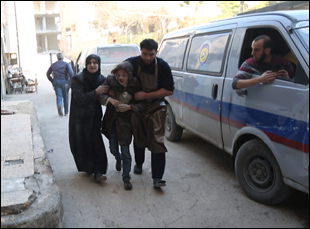
I’m a person coming from a cinematic background and I look at the frame like a still frame [where] you can study everything from inside, so I was looking for a team who could cooperate with me in this knowledge of looking at the picture as a painting and understand the movement in a picture. Every frame you can read in a very deep way, like if you analyze this frame, when the camera shakes it’s not because of the lack of experience, but because you’re using all your abilities to capture the moment, even if it’s dangerous. We were filming more of these moments in “Last Men in Aleppo” actually because the [war] in Eastern Al Gouta is the longest run siege in modern history, in the last 200 years according to the UNHR and there were obvious barbaric war crimes because chemical attacks were used and between a bomb and a bomb, it’s like two seconds. It’s not stopping. [so the shaky camera] was showing you what kind of experience you’re going through.
That [intensity also] means if you want to film, you have two choices. The first choice is you should not film or the other choice is you have to film and film in a good way because you’re putting your life at risk, so I wanted the audience to deeply understand the subject in front of them, what kind of situation they’re going through, what kind of feeling and experience [they’re having]. They feel themselves in a kind of 3D surround experience, and I wish I had the privilege of a filmmaker who can get the best equipment to film that situation, but we managed to do it with the equipment that we had. Our subject inspired us. She’s moving slowly, she’s calm, she’s dealing with the situation in this way, showing how the [women] react differently to the situation than a male.
It may have been patched together from a few different interviews, but at what point did you ask Dr. Amani to record the passages of voiceover for the film that sound as if they come from a personal journal?
Actually, this work comes with my co-writer Alisar Hasan, a Syrian journalist from a different cultural background from Amani, so they had a conversation between them about how we can reflect the experience of being a woman, and [they both] wanted to speak politically, strongly and emotionally in a way that makes people reflect and reference their own personal experience. Both of them are well-educated and clever people. Amani grew up educated as a doctor and Alisar, she was educated as a journalist and as a writer, so they would search for the best word to express the subject of Amani’s experience as well as every female living in Syria, but also connected to the [global] revolution of the feminist. This is the reason for the voiceover.
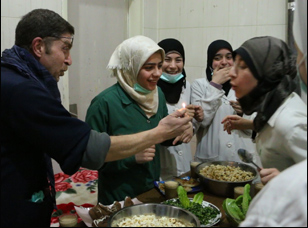
There is something good in the new technology of the camera so you can click the bottom of the camera and it can record almost 15 seconds before [it starts to film], and this is about three years [in the making] so we know the situation and we put the camera and click the bottom and then it’s recording this situation. Sometimes you’re recording one hour, just like a mise-en-scene, [looking for] a movement in the frames and you try to capture this movement, but through the experience with Samaher, we discover there’s a kind of relation that the food reflects a political and social [standing] and the personality of Samaher. She says a lot of things through the food, but she also reflects her intellect and solution for the war.
At first, we couldn’t understand directly how Samaher as a subject develops in our story, but through that experience, [we realized] she’s the person who is feeding the crew who is saving lives, so she’s the person saving the lives of the crew. We discovered that Samaher has this trauma from the system – she lost her memory from one of these bombs – because she was moving a lot because she’s get lost, and we used handheld camera with the others, but with Samaher we put the camera on and stopped it and she’s forget the surrounding because she lost her memory because of the bomb, so she’d sit for hours doing nothing, just trying to restore her memory and facing her trauma and this is the most interesting struggle that this character has.
But she is the kind of person who understands the source of the food and she criticizes the food that’s coming from this country and prefers that food from a different country and shows you through this conversation that we capture who has access to the market through the war. When she refers to [a certain area], that means there’s a black market happening and a lot of people have the benefit of that market. And she’s a fun person who reflects the idea of survival – the idea that as a human, you have something that makes you feel happy, which [in Samaher’s case] is food, which is a normal thing, so it’s something we could say is a basic need in our life. It’s also something where you think ”Oh, I’m going to eat,” and [under usual circumstances] you don’t give it attention, but you give so much attention [in a war]. Because food is such a strong cinematic language as a reflection of social life, political life, economic life and equality, this was very interesting material with Samaher where she’s sometimes moving the food in this circle and at the same time, we [have footage] where the warplane is leaving and back, leaving and back, so you feel like she’s playing a game with a gut. It’s something very powerful when we managed to put this layer together and Samaher gave us very full access to her personal moment and her bravery against her trauma from the system to build a new memory was a [big] part of the film.
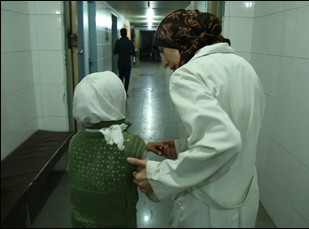
Actually, it was beyond my expectations. I wasn’t expecting that it will have a very strong reaction with an audience and a full house because we screen with Atmos sound in a big theater, and in the last screening, which was very early at 9 o’clock, my producer came and said, “It’s completely overbooked,” and Thom Powers [the head programmer for documentaries at TIFF] said, “Okay…” – he couldn’t believe it in that way. But the most interesting thing is when I start to walk in the street, people stopped me and started talking to me about their personal experience, not just about reflecting the war, which is very important about how they can do something for Syria, but also reflect on themselves.
I received e-mails from female doctors who [could see] themselves through the scene of the man challenging Amani, when she’s told “Women should stay at home,” and they say “Exactly this is what’s happened with us.” And I was stopped by two nurses who come to me and say, “This movie shows us how we can look to ourselves and think about ourselves as women, how we can do something and look to our way how we can react to our situation in the workplace,” which is great. And a man came to me, he’s a doctor and he said, “I failed myself. I’m not a good father, I’m not a good partner, I’m not a good co-worker and I have to look again at that, but your film gave me a kind of hope to think again about how I can do something for the women around me.” So it’s extraordinary and it’s making me, as a person, and Amani and Samaher feel completely happy with these reactions and it also makes me happy that the people react strongly to that and they attach strongly to the humanitarian situation and they want to do something and they give voice to this film.
“The Cave” opens on October 18th in Los Angeles at the Laemmle Royal and New York at the Metrograph. A full list of theaters and dates is here.




